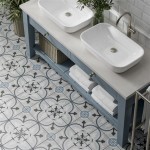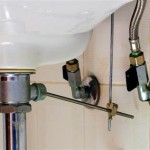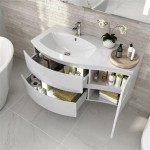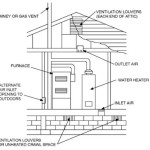Double Bathroom Sink Clogged On Both Sides: A Comprehensive Guide to Diagnosis and Resolution
The inconvenience of a clogged sink is a common household problem. However, a double bathroom sink experiencing clogging on both sides presents a unique set of challenges. Addressing such a situation requires a systematic approach that considers the potential causes and appropriate solutions. This article provides a comprehensive guide to diagnosing and resolving a double bathroom sink clogged on both sides.
The simultaneous clogging of both sides of a double bathroom sink often indicates a blockage located downstream from where the two sink drains converge. This means the problem is not likely within the individual sink drains themselves, but rather in the shared plumbing infrastructure. Understanding this fundamental principle is crucial for efficient troubleshooting.
Identifying Potential Causes of a Double Sink Clog
Determining the root cause of the clog is the first step towards effective resolution. Several factors can contribute to the simultaneous blockage of both sides of a double bathroom sink. The most common causes include:
Hair and Soap Buildup: Hair is a notorious culprit in sink clogs. It tends to accumulate in the drain pipes and form a dense mat that traps other debris. Similarly, soap scum, composed of fatty acids and minerals from hard water, builds up over time, narrowing the drainpipe's diameter and contributing to blockages. The combined effect of hair and soap buildup can significantly restrict water flow, eventually leading to a complete clog. This is especially prevalent in frequently used bathroom sinks.
Grease and Oil: Although generally associated with kitchen sinks, grease and oil can also find their way into bathroom drains. These substances solidify as they cool, adhering to pipe walls and trapping other debris. Over time, this accumulation can form a stubborn blockage that affects both sides of a double sink sharing a common drain line.
Foreign Objects: Small objects accidentally dropped into the sink, such as toothpaste caps, small toys, or jewelry, can obstruct the drainpipe. These objects may lodge themselves in narrow sections of the pipe and serve as focal points for debris accumulation, leading to a significant clog affecting both sinks.
Mineral Deposits: In areas with hard water, mineral deposits, such as calcium and magnesium, can accumulate inside the drainpipes. Over time, these deposits can significantly reduce the pipe's internal diameter, restricting water flow and contributing to clogs. The buildup tends to be gradual, and the problem might be noticeable only after considerable accumulation, affecting both sinks simultaneously.
Ventilation Issues: A properly functioning plumbing system requires adequate ventilation. Vent pipes allow air to enter the drainpipes, preventing a vacuum from forming as water flows. If the vent pipe is blocked, the resulting negative pressure can slow down drainage and contribute to clogs. A blocked vent pipe can affect multiple fixtures, including a double bathroom sink, causing both sides to drain slowly or not at all.
Sewer Line Issues: In rare cases, the problem may originate in the main sewer line. A blockage in the main sewer line can cause backups in multiple fixtures throughout the house, including the bathroom sink. If other drains in the house are also draining slowly or are backing up, a sewer line issue is the more likely culprit.
Troubleshooting Steps for a Double Sink Clog
Once potential causes have been considered, a systematic approach to troubleshooting is essential. The following steps provide a structured method for identifying and resolving the issue:
Visual Inspection: Begin by visually inspecting the sink drains and surrounding plumbing. Look for any obvious signs of blockage or damage, such as standing water in the sinks, leaks around the drainpipes, or damage to the P-trap. Check the pop-up stoppers in each sink for any accumulated hair or debris. Removing and cleaning the stoppers can often resolve minor clogs.
Plunger Use: A plunger is a fundamental tool for clearing sink clogs. Ensure there is enough water in the sink to cover the cup of the plunger. Create a tight seal around the drain opening with the plunger and apply firm, consistent up-and-down motions. Continue plunging for several minutes, then remove the plunger to see if the water drains. Since it is a double sink, you will need to seal the other drain closed to create the necessary pressure. This can be done with a wet rag or another plunger held firmly over the opening of the other sink's drain. Repeat the process as needed. If the plunger fails to clear the clog after several attempts, proceed to the next step.
Checking and Cleaning the P-Trap: The P-trap, the curved section of pipe beneath the sink, is designed to trap debris and prevent sewer gases from entering the house. However, it can also become a common location for clogs to form. Place a bucket beneath the P-trap to catch any water or debris. Carefully loosen the slip nuts that connect the P-trap to the drainpipes. Remove the P-trap and inspect it for any blockages. Clean out any accumulated hair, soap scum, or other debris. Reassemble the P-trap, ensuring that the slip nuts are securely tightened. Run water into the sink to check for leaks.
Using a Drain Snake: A drain snake, also known as a plumbing snake or auger, is a flexible tool used to break up or retrieve clogs deeper within the drainpipe. Insert the drain snake into the drain opening and carefully feed it down the pipe. Rotate the snake as you push it forward to break up or grab onto the clog. Once you encounter resistance, continue rotating the snake to break through the blockage. Slowly retract the snake, pulling out any debris. Repeat the process as needed until the drain flows freely. When using a drain snake, exercise caution to avoid damaging the drainpipe.
Chemical Drain Cleaners: Chemical drain cleaners are available in various formulations, including liquid, gel, and crystal forms. However, these products should be used with caution as they can damage pipes and pose health risks. Follow the manufacturer's instructions carefully. Wear gloves and eye protection to avoid contact with the skin or eyes. Pour the drain cleaner into the drain opening and allow it to sit for the recommended time. Flush the drain with hot water to clear the remaining debris. Avoid using chemical drain cleaners as a first resort, as they can worsen clogs by solidifying around existing blockages. Repeated usage can corrode pipes, leading to leaks and costly repairs.
Addressing More Complex Clogs
If the previously described troubleshooting steps fail to resolve the clog, it may indicate a more complex issue that requires specialized tools or professional assistance. Some common situations that warrant professional intervention include:
Deep Blockage: If the clog is located deep within the plumbing system, beyond the reach of a standard drain snake, a professional plumber may be required to use specialized equipment, such as a motorized drain auger or hydro jet.
Pipe Damage: If the drainpipes are damaged, corroded, or collapsed, they may need to be repaired or replaced. This type of repair typically requires the expertise of a qualified plumber.
Sewer Line Blockage: If the clog is located in the main sewer line, it can cause backups in multiple fixtures throughout the house. A professional plumber with specialized equipment, such as a sewer snake or video inspection camera, is needed to diagnose and resolve the issue.
Ventilation Problems: Identifying and resolving ventilation issues often requires the expertise of a professional plumber. They can inspect the vent pipes for blockages and ensure that the plumbing system is properly ventilated. A blocked vent can often create a siphon effect, slowing down the drainage of the water and causing the double sink to clog simultanesouly.
When faced with a persistent or complex clog, seeking professional assistance is often the most prudent course of action. Plumbers have the knowledge, experience, and tools necessary to diagnose and resolve a wide range of plumbing problems efficiently and effectively. Attempting to resolve complex issues without proper training or equipment can lead to further damage and increased repair costs.
Preventative measures are crucial for minimizing the risk of future clogs. Regularly flushing the drain with hot water can help prevent the buildup of soap scum and grease. Installing drain strainers in the sink drains can catch hair and other debris before they enter the drainpipes. Avoid pouring grease or oil down the drain. Periodically cleaning the P-trap can also help prevent clogs from forming.
Addressing a double bathroom sink clogged on both sides requires a systematic approach that considers the potential causes, appropriate troubleshooting steps, and when to seek professional assistance. By understanding the common factors contributing to such clogs and implementing effective preventative measures, homeowners can minimize the inconvenience and expense associated with plumbing problems.

4 Easy Ways To Unclog A Double Sink Wikihow

How To Fix A Clogged Sink

4 Easy Ways To Unclog A Double Sink Wikihow

Both Sides Of My Sink Are Clogged Tiktok Search

Why Is My Kitchen Sink Clogged On Both Sides Ps Plumber Singapore
Discover When Double Vanities Are The Trouble
What Would Cause Sinks To Back Up Into Each Other They Re On Opposite Sides Of The Same Wall I Tried Drano Quora

Clogged Drain In Both Sides Of Sink Tiktok Search

Why Is My Double Kitchen Sink Backing Up To The Other Side Flohawks Plumbing Septic

Why Is Your Kitchen Sink Clogged On Both Sides Doityourself Com
Related Posts







